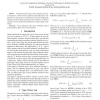203 search results - page 3 / 41 » On interval fuzzy negations |
TFS
2008
13 years 7 months ago
2008
Abstract-- We introduce a new way of looking at fuzzy intervals. Instead of considering them as fuzzy sets, we see them as crisp sets of entities we call gradual (real) numbers. Th...
EUSFLAT
2009
13 years 5 months ago
2009
Abstract-- This paper examines type-2 fuzzy arithmetic using interval analysis. It relies heavily on alpha-cuts and alpha-planes. Furthermore, we discuss the use of quasi type-2 fu...
EUSFLAT
2003
13 years 9 months ago
2003
Intuitionistic Fuzzy Sets Theory is based on a wrong nominalistic (terminological) assumption. It is defined as “intuitionistic” a negation which does not satisfy usual prope...
ISCI
2007
13 years 7 months ago
2007
Fuzziness (entropy) is a commonly used measure of uncertainty for type-1 fuzzy sets. For interval type-2 fuzzy sets (IT2 FSs), centroid, cardinality, fuzziness, variance and skewn...
FSS
2007
13 years 7 months ago
2007
The characterization of S-implications generated from strong negations presented firstly by Trillas and Valverde in 1985 is wellknown in the literature. In this paper we show tha...

